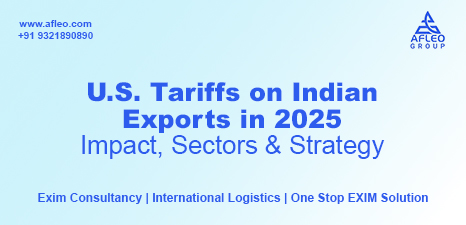The United States has been among India’s largest economic benefactors for decades, and India-American trade has come a very long way since then. Indian exporters are, however, getting badly hit because of America’s tariffs against India. The implications of the tariffs are problematic until 2025, shaping trade policies and business strategies.
Latest Update
- Apr 10, 2025:- President Donald Trump Announces 90-Day Pause On Tariffs.
The Evolution of U.S. Trade Tariffs on India
The history of US tariffs on India imports traces its roots back to the trade policy during the President Donald Trump regime. His administration had aggressive trade policies, hiking tariffs on a range of products, including auto tariffs and auto parts, on the grounds of safeguarding local industries. 25 percent tariffs were imposed in some instances, targeting India’s automobile industry and other important sectors.
Though successive governments have entered into trade talks to remove these hurdles, tariff problems still continue. For instance, the White House has repeatedly mentioned a trade deficit as justification for imposing tariffs on Indian exports. In 2025, India will keep knocking on diplomatic and trade doors to reduce these tariffs.
Recent Tariff Adjustments
New Tariff Rate: The U.S. has increased tariffs on Indian exports to 26%, effective April 5, 2025. This marks a significant change from previous rates and will impact a broad range of products. (Note: Some sources mention 27% – the finalized rate confirmed in the April 2 Executive Order is 26%)
Implementation Timeline:• April 5, 2025: An initial levy of 10% will be applied.
• April 9, 2025: The full 26% tariff rate will be enforced.
The Projected Effect on Major Sectors
Although the full extent is yet to be realized, companies in these sectors need to actively review their plans to avoid potential disruptions.
- Auto and Auto Components: Higher levies on vehicles and auto parts could be burdensome for Indian manufacturers, compelling them to rearrange their prices and supply chain in a bid to compete within the US market.
- Steel and Aluminium: A flat 25% tariff has been levied. While aluminium is generally considered exempt in certain HS codes, many aluminium-based products will still attract duties. Exporters must verify classification.
- Textiles and Pharmaceuticals: India’s export leadership in these segments is under pressure. Although some Active Pharmaceutical Ingredients (APIs) are exempt, many pharmaceutical formulations are not. Businesses must conduct granular-level checks.
While the full potential is yet to be achieved, firms in these industries must actively reconsider their plans so as not to disrupt the status quo.
Scope of Affected Products
The tariff adjustments encompass over 3,000 product lines across various sectors, including:
- Chemicals
- Minerals
- Fuels
- Rare metals
Exemptions: Certain products are excluded from these tariffs, such as:
- Copper
- Select Aluminium grades
- Bauxite
- Fluorspar
- Graphite
- Active Pharmaceutical Ingredients (APIs)
- Various chemicals
Note: Exporters should consult Annex II of the official U.S. Executive Order to verify specific product exemptions. If permitted, the full Annex II list may be provided on request or accessed via official trade portals.
The Function of Trade Agreements
Efforts to battle the impact of U.S. tariffs on India have been aimed at obtaining a comprehensive trade agreement. The two nations have pursued a bilateral trade agreement which will reduce tariffs on certain products.
The Indian government, headed by Minister Piyush Goyal and Prime Minister Narendra Modi, has been actively involved in negotiating with other officials and the U.S. Trade Representative for a fair trade agreement. A prime area of concern was the tariffs on Indian exports, such as those involving imports worth 23 billion dollars.
Comparative International Context
India is among over 70 countries affected by this tariff realignment. Notably:
- Lesotho: Assigned a 50% tariff rate.
- Nigeria: Assigned a 14% tariff rate.
This indicates a non-uniform application of tariffs, reflecting varying U.S. trade balances and policies with different nations.
Additional Insights from the April 2025 Executive Orders
The Executive Order dated 2 April 2025-referred to by the US administration as ‘Liberation Day’-marks a turning point in US trade policy, affecting nearly all global trading partners, including India. Here are the key highlights and nuanced developments relevant for Indian exporters:
- Updated Tariff Rate for India: 26% tariff on most Indian imports, effective 9 April 2025, following a baseline tariff of 10% from 5 April 2025.
- Auto Parts Tariff (Effective 3 April 2025): 25% on non-U.S. auto components including engines, powertrain components, and electrical systems.
- Steel and Aluminium Tariffs (Effective 12 March 2025): 25% flat tariff imposed across countries.
- Comparative Advantage: India’s 26% tariff still compares favorably to China (34%) and Vietnam (46%). This gives Indian exporters an 8% and 20% pricing edge, respectively, in the U.S. market-especially relevant for textiles, processed food, and chemicals. Indian manufacturers can leverage this to retain or expand U.S. market share.
- USMCA Exemptions for Canada and Mexico: Despite 25% baseline tariffs, many products are exempt under USMCA, giving them a preferential edge.
- Ad Valorem Duty Applicability: Duties apply only to the non-U.S. content in imported items, if at least 20% value comes from U.S.-origin inputs-creating room for hybrid sourcing and value-add strategies.
These policy shifts underscore the need for Indian businesses to stay agile and informed. While the tariffs present immediate challenges, India’s comparative positioning and ongoing global trade agreements could help cushion the impact and even open new avenues of trade expansion.
Key Figures and Trade Statistics
- India’s overall trade with the U.S. has reached $66 billion in recent years.
- Tariffs on 55 specific Indian products remain a negotiation point.
- The South and Central Asia trade representative continues to play a key role in shaping dialogue.
Strategic Recommendations for Exporters
- HTS Code Verification: Use precise Harmonized Tariff Schedule classification to determine duty applicability and avoid surprises.
- Pricing and Supply Chain Assessment: Factor in the increased costs while planning export pricing and assess opportunities for regional value addition.
- Regulatory Monitoring: Stay closely updated on trade notices, Executive Orders, and potential retaliatory measures by India.
Clarifications and Strategic Advantages for Exporters
1. Verify Product Exemptions – Consult Annex IIGiven the wide scope of the U.S. tariff adjustments-covering over 3,000 product lines-many exporters may find it challenging to determine whether their specific goods fall under the exempted categories. To address this, exporters are strongly advised to consult Annex II of the official U.S. Executive Order, which provides a detailed list of exempted products.
Download Annex II – Product Exemption List (PDF)
Ensuring correct HS code classification and verifying product eligibility against this annex can help avoid costly misinterpretations and unnecessary duties.
2. Understanding India’s Comparative AdvantageAlthough India now faces a 26% tariff rate on exports to the U.S., it still holds a comparative pricing advantage over key competitors like China and Vietnam. Chinese exports are currently subject to a 34% tariff, while Vietnamese goods face an even steeper 46% rate. This creates an 8% and 20% margin, respectively, that Indian exporters can leverage to maintain or grow their market share in the U.S. This advantage is particularly relevant in high-demand sectors like textiles, processed food, and specialty chemicals, where pricing plays a key role. Indian exporters can use this favorable margin to:
• Offer competitive pricing while retaining healthy margins
• Negotiate better contracts with U.S. importers
• Displace competitors from China and Vietnam in price-sensitive segments
Tariff Rate Comparison Chart:
| Country | Tariff Rate (%) | Price Advantage for India |
|---|---|---|
| India | 26% | – |
| China | 34% | 8% |
| Vietnam | 46% | 20% |
This cost differential offers Indian exporters a strong negotiation and expansion opportunity in the U.S. market, especially in light of recent supply chain realignments and the need for import diversification.
The Future: What’s Next?
Trade analysts foresee the development of a new trade-weighted tariff model. India may also consider retaliatory duties to balance trade asymmetries.With a new U.S. administration and global geopolitical shifts, both sides are re-evaluating their positions. Continued diplomacy may result in tariff rollbacks, improved quota systems, or preferential treatment for key Indian sectors.
Implementation Details
- In-Transit Goods: Goods loaded and shipped before the implementation date will not be subject to new tariffs.
- Additional Duties: These are over and above existing duties, taxes, and other levies.
Conclusion
The U.S. levies on India are still a major concern, but continued trade negotiations and diplomatic efforts hold the promise of resolution. As India and America continue dialogue, companies need to be aware of policy shifts and adjust to the changing global trade environment. With proper strategies and agreements in place, India can solidify its position as a major global trading partner while preserving export growth for years to come.
How Afleo Can Help
At Afleo, we specialize in:
- Helping businesses start their export-import operations, including IES registration and policy guidance
- DGFT & Customs Consultancy Services – from Advance Authorisations to EPCG, RoDTEP, RoSCTL, and more
- End-to-end Freight Forwarding services – including Customs Clearance, Transport, and Container Bookings
- Providing expert compliance support for handling U.S. and EU trade regulations, documentation, and procedural checks
Partner with us to navigate global trade with confidence, agility, and strategic foresight.
Have any doubts? Please fill the form below to get in touch with us.
[ninja_form id=12]

